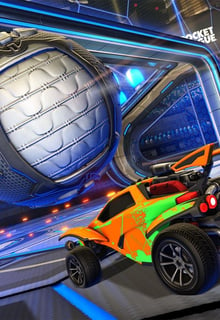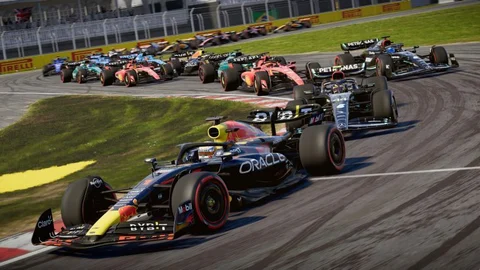A good setup is a must for winning races in F1 23. The F1 cars are set up differently for each individual track. In this article we explain what the different setup settings do and how you can drive faster with them.
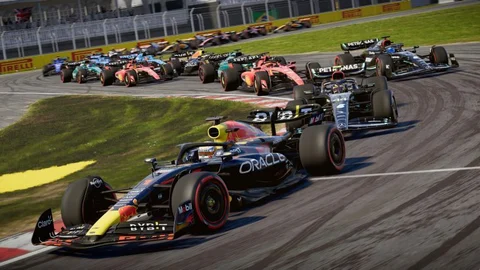
F1 23 is an all-round successful racing game, Codemasters and EA have done a good job here. The gameplay is really good, the driving experience is outstanding and the servers are stable.
We have already explained how you get faster in F1 23. In that article, we talked in particular about the driving assists, which you should definitely turn off in order to become faster.
Now we will explain in detail what the different settings mean when setting up a Formula 1 car - and how to adjust them correctly.
Formula 1 setups are a science in themselves, each car can be driven differently and you need to use a different setup for each track. Good setups make your car several seconds faster per lap, so it's worth investing time here to make up time on the track.
F1 23: How Setups Work
Setups are used to set up the car for the track. You can change various settings that affect the performance of the car.
High settings for the front wing, for example, result in the car having enormous downforce and thus coming around the corners faster. At the same time, you lose speed on the straights, which makes overtaking much more difficult. So, depending on the track, you have to find a good balance between downforce and top speed. Traditionally, Monaco is driven with the highest downforce and Monza with the lowest.
We'll now explain what the different settings on the setup mean and how it affects performance.
F1 23 Setups: Fuel Load
Fuel load is one of the least important settings, especially in time trials. In the race, however, it becomes more interesting because you can also be tactical with the fuel load. The less fuel you take, the lighter and faster the car becomes. The heavier the car, the more it understeers. So you should have driven each setup once with a full tank to know how the car behaves at the start of the race.
Determine the amount of fuel needed for the car. A full tank of 110 kg will usually lose around 3 seconds of performance compared to a minimum fuel load.
Aerodynamics
This is where the downforce of the car is regulated. High wing settings give better downforce, while low wing settings lead to higher top speed.
If you drive more front wing than rear wing, you have a superior turn in fast corners, but the rear becomes quite unstable when you touch kerbs, for example.
If you drive less front wing than rear wing, you still have a good speed at the entrance of the corner, but that changes immediately when you hit the throttle again. This causes a lot of understeer, which means that the car no longer has the usual turn in. The advantage of this wing setting is enormous grip and good traction on corner exit.
Set up the front and rear wings to achieve the desired aerodynamic behaviour and balance. Higher wing angles create more downforce, which improves grip, but also increases drag, which greatly reduces speed on straight tracks.
Preferably, you should drive more front wing than rear wing in F1 23. For a good balance you should set about 10-15% more front wing to get the necessary downforce. Of course, this does not apply to every circuit. In Canada, for example, you will tend to drive more rear wing to get better traction out of the corners.
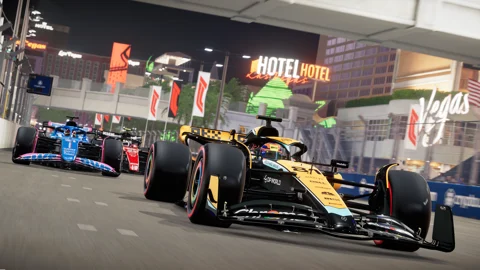
Transmission (Differential)
When adjusting the differential with the throttle, we traditionally recommend 50%. This provides good oversteer in fast corners, but at the same time the traction is still good enough. If you drive with 60-75%, the car tends to understeer, but the traction gets better.
The differential without throttle will settle between 50 and 55% in F1 23. The lower you set the differential without throttle, the more oversteer the car will have. You will hardly find setups that use more than 60% here, unless you drive on a wet track. There, oversteer is not really advantageous because you want to drive a stable car in the rain.
Adjusting the car's differential affects how power is transmitted to the rear tyres. An unlocked differential allows the tyres being driven to spin faster, while a locked differential forces both tyres being driven to spin at the same rate. The advantages of a more open setup are low tyre wear and a more gradual transfer of grip loss, while a more locked setup can grant an advantage in absolute grip.
Suspension Geometry
The camber angle determines how the wheel is vertically aligned. A negative camber means that the wheel is inclined towards the bolide. Adjusting this angle will affect the tyre contact with the track. Decreasing the value can increase lateral grip in longer corners, but also decreases longitudinal grip. Excessive camber can have negative effects on tyre wear.
- Front camber: Setting the front camber all the way to the left gives better turn-in in medium-fast and fast corners, but more understeer in slow corners. If you set the front camber all the way to the right, you have a good balance for all kinds of curves, especially for slow corners.
In general, however, it can be said that you will hardly notice any changes in performance with the front wheel camber, unless you move between the extremes. Probably settings towards -2.50 will prevail, because this is gentler on the tyres.
- Rear camber: If you set -2.00, you have a minimally better turn in when braking into corners, but traction is slightly worse. However, if you touch a notch, the car quickly becomes unsteady. Kerbs in high-speed curves are easier to attack. The opposite setting, namely 1.00, means that you have good traction out of slow corners. This is still true even if you have steering lock when accelerating. However, on fast corners the car becomes unsteady.
You should tend to move towards 1.00 here, although these settings do not make much difference to performance either.
- Front toe-out: If you set 0.00, you have a decent pace at the entrance of the corner, but this setting only comes into its own at the exit of the corner, as you hardly have any understeer here. The opposite, 0.10, means that you have a lot of grip at the entrance to the corner, but you get a lot of understeer in medium-fast and fast corners.
The front track to the left, i.e. settings between 0.00 and 0.02/0.03, will prevail in F1 23.
- Rear toe-in: The Left (0.10) setting is good for pace in medium-fast and slow corners, but very unstable in fast corners. The right setting (0.30) gives good turn-in in medium-fast corners and good stability in fast corners, even if you have some understeer there.
Suspension
Stiff suspensions keep the car from bouncing forward under aggressive braking or backward under sudden acceleration. While this improves aerodynamic stability, it can put a lot of stress on the tyres and cause the vehicle to swing wildly on bumps. Lightweight suspensions absorb bounces more effectively, but sudden acceleration or braking can cause the vehicle to swing aggressively, negatively affecting aerodynamic stability.
- Front suspension: Setting a soft suspension gives good stability, but at the cost of understeer in fast corners. Furthermore, a soft suspension is extremely slow on the straights, in Qatar you lose about 2.5 tenths here. A stiff suspension leads to oversteer, but a better performance all round.
We assume that the hardest possible front suspension will be used on almost all tracks.
- Rear suspension: Setting a soft suspension leads to a good turn in (at the expense of understeer on corner exit). Here, a soft suspension is about 0.5 tenths faster on the straight than a hard suspension. A hard suspension is understeering at the entrance of the corner, but you have more oversteer in fast corners. However, oversteer also leads to poor traction, which is why a soft rear suspension will prevail.
- Front stabiliser: A soft stabiliser is oversteering in all corners, but traction is poor. A hard anti-roll bar tends to understeer, but traction is really good, and the rear end is quite smooth. We tend to recommend a softer to medium stabiliser here.
- Rear stabiliser: A soft stabiliser tends to understeer, but is very helpful in large braking zones. A hard stabiliser is oversteering, especially in fast corners. This applies to corner entry and exit. Large braking zones are difficult with these settings, and kerbs should be avoided completely. On tracks with many hard braking zones we recommend a soft stabiliser. If there are few braking phases (such as in Qatar), you should use a harder stabiliser.
- Ride Height: In general: the lower the settings, the better. The more ride height, the less downforce the car has. Low settings at the front provide more grip at the entrance to the corner, low settings at the rear provide more grip at the exit from the corner.
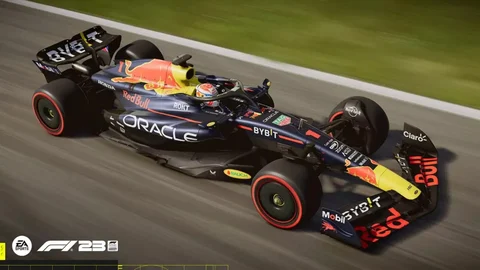
Brakes
Brake pressure should always be set to 100% to achieve maximum braking power.
- Front Brake Bias: Here you should drive as low as possible. In qualifying this would be 50-52%, you would only use a higher setting for hard braking zones. In the race we recommend 53-55%, again you can distribute more power to the front axle when braking hard. We would advise this especially if your tyres are already significantly worn.
Brake pressure determines the maximum potential of the vehicle's braking power. Even though increased brake pressure provides a shorter braking distance, the wheels lock up much more easily, especially on wet or uneven surfaces, reversing the effect and greatly reducing braking power.
Tyres
The more tyre pressure you run, the better grip you have and the faster the car is on the straights. However, this quickly leads to overheating of the tyres, which can even happen after one lap in qualifying. A higher tyre pressure at the front leads to more grip when entering corners. In the race, you should keep the tyre pressure as low as possible to preserve your tyres.
Softer tyres have a larger surface area and therefore improved grip, but lose sensitivity to high loads. Increasing tyre pressure can also reduce rolling resistance and thus increase speed on straight stretches. Increased tyre pressure also contributes to higher tyre temperatures.
Those were our detailed explanations of each setup setting in F1 23, now you can easily build your own setups to suit your driving style. Note that each track needs its own setup. This also applies to different cars when driving on realistic car performance in the career.






















